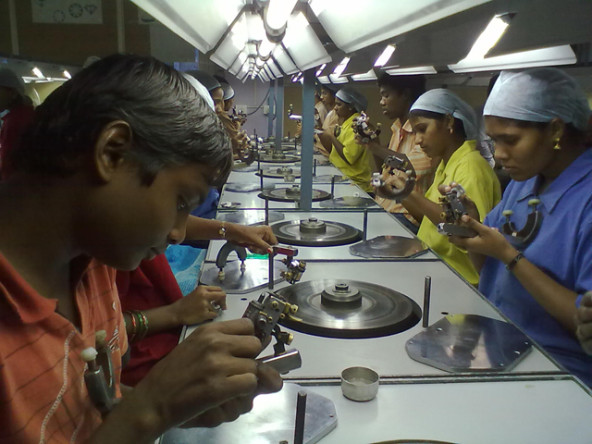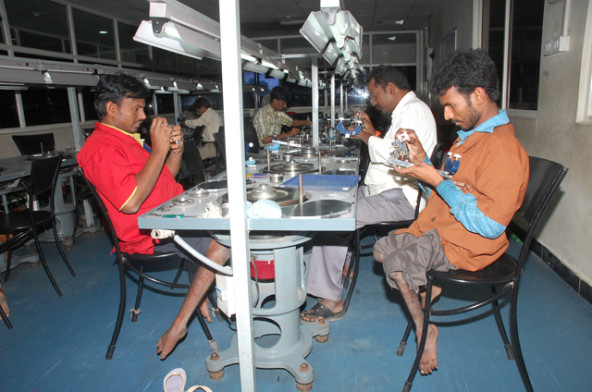 Gitanjali gems factory.
Gitanjali gems factory.
Gitanjali Gems operates a diamond cutting, polishing, and jewellery-making business in Hyderabad, India. Given the lack of trained manpower, the company faces a major challenge. In this context, Gitanjali Gems has made training and hiring disabled youth an integral part of the company’s human resource strategy. The turnover rate for its disabled employees is 1 percent compared to the industry average of 10-15 percent. In most months, a disabled employee wins the productivity award, even though they constitute only 12 percent of the company’s current workforce of 2,500. With productivity and cost advantages on its side, Gitanjali Gems is planning to triple its workforce in the next two years and aims to recruit 1,000 people with disabilities as a central component of its growth strategy. Madhusudhan Reddy, Gitanjali Gems’ vice president of human resources, says, "Most employers suffer from preconceived notions about the disabled, so they see only weaknesses. They are differently abled, not disabled—once you frame them that way, you see their strengths.”
Around the world, people with disabilities face significant barriers to employment. The best way to help them is often to help them secure a decent job—something the Center for Persons with Disability Livelihoods (CPDL) has been doing successfully with Gitanjali Gems and other clients. CPDL is a public-private partnership between Youth4Jobs (Y4J), a private-sector foundation, and the government that uses a market-oriented approach to help disabled youth get a job in the formal sector.
About 600 million people live with a disabilities according to the International Labor Organization, which promotes decent work as the most effective way of getting out of the vicious cycle of marginalisation, poverty, and social exclusion. Poor people are more at risk of acquiring a disability due to lack of good nutrition, health care, sanitation, and safe living and working conditions. People with disabilities face barriers to education, employment, and public services that could otherwise help them escape poverty. Buildings and transportation are often inaccessible. They also often suffer from social discrimination, stereotypes, and exclusion. As in the general population, there are strong gender and geographic differences among people with disabilities; women and girls in rural areas are often the most disadvantaged.
In India, there are an estimated 70 million people with disabilities—5.6 percent of the country's population. In Indian society, there is a deep-rooted social stigma toward body impairment or disfigurement as “inauspicious,” thus limiting interaction between people with disabilities and the rest of society. On its own, the government has initiated a plethora of programs to promote employment for them, but the impact to date has been negligible. In 2008, for example, the Indian Finance Minister allocated $360 million for a program to reimburse employers who provide jobs to disabled workers. The aim was to create 100,000 jobs per year, but after three years, the program had generated only 465 jobs.
CPDL’s Bold Vision
Are you enjoying this article? Read more like this, plus SSIR's full archive of content, when you subscribe.
The ambitious vision of the CPDL is to make inclusive employment of people with disabilities the norm in Indian companies. The organization was jointly founded in 2010 by Youth4Jobs, a nonprofit organization that works across India to train impoverished young people and harness India's demographic dividend, and the Society for Elimination of Rural Poverty (SERP), which is part of the Rural Development Department of the state government of Andhra Pradesh. CPDL is an unusual partnership between government and a group of committed team members with a private sector background. Its expertise lies in working on the entire labor value chain, taking young people with disabilities from unemployment/underemployment to a formal sector job. This involves identifying and motivating new workers, training them to meet demands of the market, inviting companies to recruit them, and mentoring them in their new workplace. CPDL offers training in ten different sectors: hospitality, retail, banking and finance, business process outsourcing, information technology, telecommunications, health care, textiles, and manufacturing. The youth are channelled to the most appropriate sector, based on their competencies and abilities; for example, illiterate youth tend to go into manufacturing and textiles, those with basic literacy into hospitality, and more educated young people into information technology.
 Disabled youth at work, Gitanjali Gems
Disabled youth at work, Gitanjali Gems
CPDL has developed a customized curriculum based on practical situations that people with disabilities will encounter once employed. It also involves companies from the first day of training, which both sensitizes the companies and provides exposure to the students. Company staff give guest lectures, share their training modules, and mentor the youth in the classroom. Youth learn English communication and basic computer skills. Soft skill building is also an integral part of the curriculum, and includes lessons on grooming, health, hygiene, and body language. The last fifteen days of the program include specific sector trainings, depending on job vacancies and youth aspirations. Sectors include high-growth areas such as retail, hospitality, IT and IT-enabled services, and finance.
Y4J has formed a network of 200 companies with which it works, including firms such as McDonald's, KFC, ITC Hotels, HDFC Bank, Tata Teleservices, and Unilever. After the recruiting company has assessed worker competencies, they make job placements; no special concessions are made for the disabled other than simple workplace adjustments. Companies are beginning to realize that people with disabilities are an underused labor resource capable of hard work—in fact, they are generally eager to prove that their disability is not a deterrent to performance, leading to higher productivity.
Disabled youth are also very loyal to employers, and firms find that they quickly recover any expenditure made in infrastructure adjustments and hiring costs. The companies also get a government subsidy that amounts to about 15 percent of the payroll cost of hiring people with disabilities. Aside from financial benefits, companies also get a public relations boost, and the disabled workers feel good about the competency-based approach.
Between October 2010 and December 2012, CPDL trained 3,200 young people with disabilities. Of these, 72 percent have successfully gained employment. Ninety percent of the recruiting companies are first-time employers of workers with disabilities.
People with disabilities comprise the world’s largest minority group. Organizations can replicate the CPDL model wherever market opportunities exist. It demonstrates that when companies, government, and disabled communities come together on one platform, it is a win-win for everyone. Companies get an alternative pool of loyal trained youth; governments move closer to their Millennium Development Goals, and the disabled youth and their families escape the vicious cycle of poverty.
Support SSIR’s coverage of cross-sector solutions to global challenges.
Help us further the reach of innovative ideas. Donate today.
Read more stories by Aneel Karnani, Kevin McKague & Meera Shenoy.

